Leith Corporation Tramways
History
Leith Corporation became a tramway owner and operator on the 23rd October 1904, when it took over the remaining assets of the standard-gauge, horse-drawn Edinburgh Street Tramways Company, at a price that had been mutually agreed. The ESTCo had begun tramway services within Leith over 30 years before this, and in its prime, had operated just over 18 miles of tramway in Leith, Edinburgh and Portobello.
By the time of its sale to Leith Corporation, the ESTCo was a shadow of its former self, Edinburgh having compulsorily purchased the vast majority of its system, most on the 9th December 1893, but with further lines following in 1896 and 1898. Edinburgh initially leased operation of its newly acquired system to Dick Kerr and Company, which quickly set up a subsidiary to work it, the Edinburgh and District Tramways Company. Leith Corporation, however, was less than pleased with what it saw as Edinburgh's high-handed manner, and it soon struck a deal for the ESTCo to continue operation in its area, but in return for, amongst other things, building new lines.
Edinburgh Corporation's take-over caused operational chaos at the Edinburgh/Leith municipal boundary at Pilrig, horses and crews having to be changed whilst passengers sat in the horse trams, which were worked through from one company's territory into the other's. Over a period of a decade, multiple attempts were made to reunify operation, though all were destined to fail, some due to differences between the two companies, and some to tensions between the two burghs. If anything, these only got worse when Edinburgh Corporation decided to build an expensive cable-tram system, a mode of operation that Leith eventually rejected. The much-ridiculed changeover at the municipal boundary at Pilrig, where Edinburgh's cable trams met the ESTCo's horse trams, and later, Leith Corporation's electric trams, only being resolved following the merger of Leith into a much-enlarged Edinburgh in 1920.
Having agreed a purchase price with the ESTCo, Leith Corporation duly obtained powers to buy it, as well as to use mechanical power and build additional lines; these powers were granted on the 24th July 1904 under the Leith Corporation Tramways Order Confirmation Act 1904. The council was, however, still undecided as to what form of mechanical power it wished to use, though it was definitely not cable haulage. On the 11th October 1904, the council formally decided to use overhead electric traction, just two weeks before it was to take over operation from the ESTCo.
Work commenced on reconstructing the horse-tramway on the 6th February 1905, the first new line (from Leith Walk, via Pilrig Street and Newhaven Road to Stanley Road) opening on the 15th June 1905 using horse traction, electric services commencing some two months later on the 18th August 1905. Further lines were quickly converted, with the last horse services being withdrawn on the 2nd November 1905 (on the Seafield Road line). The remaining authorised electric lines — including Bernard Street Bridge and Seafield Road were opened on the 21st November 1905.
The system now settled down to an efficient and profitable existence, the operating costs routinely being the lowest of any Scottish tramway system. The corporation discussed various extensions to its system, the Leith Burgh Act of 1908 including powers for extensions from Newhaven to Granton, and from Granton via Goldenacre and Ferry Road to Bonnington Terrace, where it would intersect the Pilrig Street and Junction Bridge lines. These extensions were opened as follows: Newhaven to Granton via Lower Granton Road (11th May 1909); Granton to Goldenacre via Higher Granton Road (2nd July 1909); and Goldenacre to Bennington Terrace (3rd August 1909).
As with the vast majority of tramways, the system was badly impacted by the Great War through loss of skilled men to the armed forces, restrictions on spares and new materials (e.g., rails), and heavy passenger loadings. By the end of the war, it was clear that the future of the system would not be as an independent entity, but that it would be merged into the larger Edinburgh Corporation system, which the latter took over from its lessee on the 1st July 1919.
The legislation necessary to create the enlarged Burgh of Edinburgh was passed into law on the 5th November 1920 under the Edinburgh Boundaries Extension and Tramways Act 1920. Two weeks later, on the 20th November 1920, Leith Corporation Tramways was merged into its larger neighbour, Edinburgh Corporation Tramways.
Leith Corporation Tramways operated 9.09 miles of standard-gauge, overhead electric tramway; although it met the tracks of the Edinburgh and District Tramways Company (Edinburgh Corporation Tramways from July 1919 ) at Pilrig on Leith Walk, there were no through services, as the Edinburgh system was cable hauled. The Leith system was centred on the Foot of Leith Walk, where lines ran eastwards to Seafield Road (via Duke Street, Hermitage Place and Seafield Place); southwestwards along Leith Walk to Pilrig; northwestwards along Junction Street, through Junction Bridge to Commercial Street; and northeastwards along Constitution Street, then northwestwards along Bernard Street, Commercial Street and Lower Granton Road to Granton. Further lines ran westwards from Junction Bridge via Bonnington Terrace, Ferry Road, Goldenacre and Higher Granton Road to Granton; and northwestwards along Pilrig Street, through Bonnington Terrace and Stanley Street to Newhaven.
Uniforms
Leith Corporation operated horse trams for just over a year, from 23rd October 1904 to the 2nd November 1905. Following the corporation takeover, the men working these services were issued with new uniforms, though details are a little sketchy. Conductors seem to have been issued with single-breasted jackets with lapels, whilst drivers were possibly provided with double-breasted lancer-style tunics bearing five pairs of buttons; both styles of jacket bore stand-up collars, seemingly devoid of insignia. The peaked caps were of the tensioned-crown type; they bore system initials — 'L C T' — in individual metal letters, almost certainly brass.
Horse-tram crews were also issued with long, double-breasted, heavy duty greatcoats with high fold-over collars; once again, these garments do not appear to have carried any badges.
Staff working the newly inaugurated electric services, which commenced on the 18th August 1905, were issued with double-breasted, lancer-style tunics with five buttons (narrowing from top to bottom and bearing the system title and municipal device — see link) and stand-up collars; the latter carried 'L C T' system initials on both sides in individual metal letters, almost certainly brass to match the buttons. The tensioned-crown peaked caps also bore the system initials — 'L C T' — in brass letters, though these were eventually replaced by a shield-shaped brass cap badge comprising the Leith municipal device, with the full system title in a ribbon underneath. It is unclear exactly when this change took place, as though documentary evidence suggests that it was in 1908, a photograph below, which was purportedly taken in 1906, clearly shows the new badges.
It is unclear what style of uniform jacket was provided to senior staff during the system's early years as all surviving photographs show them wearing long, double-breasted overcoats. In later years, however, it is believed that inspectors wore double-breasted, three-quarter length coats, very similar to those used on Glasgow Corporation Tramways. The four buttons, which were presumably of the standard LCT pattern, were closely spaced; the jacket bore lapels, and the collars carried the grade — 'Inspector' — in embroidered script lettering. In later years, the tensioned-crown peaked caps bore a hat band with the grade — 'Inspector' — in embroidered script lettering; although similar caps were worn in the early years, it is currently unclear what badge they bore.
Inspectors were also issued with long, double-breasted overcoats bearing four pairs of buttons (plain, i.e., unmarked) and lapels; the collars bore the grade — 'Inspector' — in embroidered script lettering.
The LCT also had one or possibly two chief inspectors. A photograph that depicts one such individual, shows him wearing a long, three-quarter length, double-breasted coat with four pairs of closely spaced buttons, and with lapels; the collars bear his grade — 'Chief Inspector' — in embroidered script lettering. Although the cap was very similar to those worn by ordinary inspectors, the hat band certainly bore two-lines of embroidered script lettering, presumably 'Chief Inspector'.
In common with many UK tramway operators, Leith employed female staff in significant numbers during the Great War — both as conductresses and as motorwomen (called motoresses in Leith) — to replace men lost to the armed services. The decision to engage women was taken in October 1915, the first eight conductresses commencing their duties (on the Ferry Road route) just two months later in December 1915, with training to drive the trams taking place at the end of 1916. Conductresses, and possibly motorwoman too, were provided with single-breasted jackets with five buttons, two button-closed breast pockets, two button-closed hip pockets, a waist belt (with button fastening), epaulettes (with button fastenings) and lapels, along with a long matching skirt. Other than the buttons, the jacket was completely devoid of insignia. Conductresses wore dark-coloured straw bonnets, which bore a hat band bearing the standard municipal tramways cap badge. Motorwomen on the other hand, appear to have worn baggy peaked caps, sometimes called motor caps; these also bore the standard tramways cap badge.
Conductresses and motorwomen were also provided with long, double-breasted topcoats with high, fold-over collars (devoid of insignia).
From 1918, the LCT also made use of the services of inspectresses. A surviving photo below shows an inspectress in an unmarked double-breasted lancer-style greatcoat (with high fold-over collars), so it is unfortunately not possible to state the style of uniform jacket worn underneath. Headwear took the form of a baggy peaked cap, which bore the standard LCT cap badge.
My thanks go to Alan Brotchie for providing many of the photographs and much of the background information.
Further reading
For a history of Leith Corporation Tramways, see: 'Edinburgh's Transport - Volume 1, The Early Years' by D L G Hunter; The Mercat Press (1992).
Images
Horse tram drivers and conductors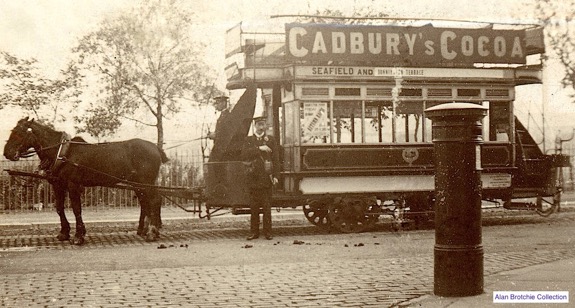
An unidentified horsecar, still in Edinburgh Street Tramways Company livery, at the foot of Restalrig Road — photo undated, but probably taken in the last week of horse-tram operation, possibly on the last day (2nd November 1905). 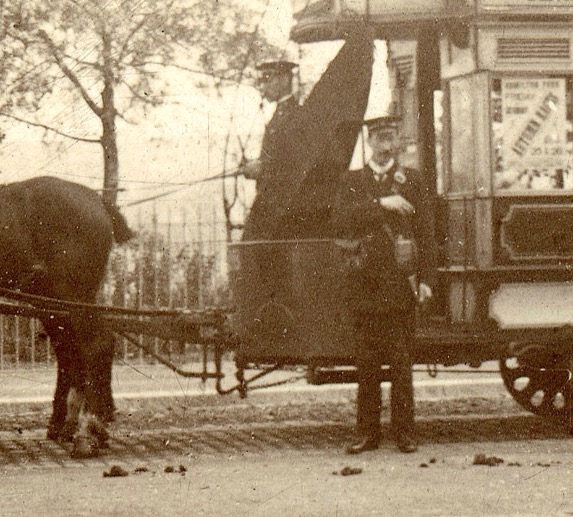
An enlargement of the above photograph showing the crew. The conductor is wearing a single-breasted jacket with lapels, whilst his colleague appears to be wearing a double-breasted lancer-style tunic. Both men are wearing tensioned-crown peaked caps.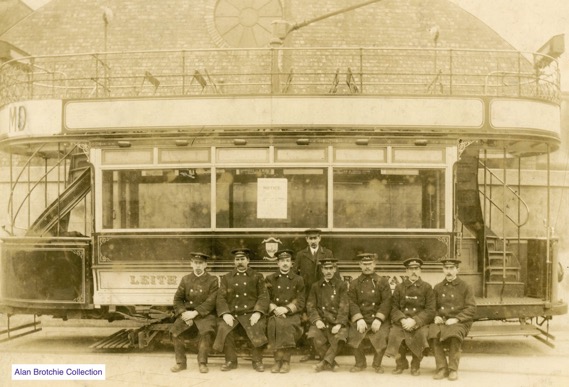
A group of Leith tramcar staff, very probably horsecar crews, seated in front of a newly delivered electric tram outside the new electric depot — photo undated, but almost certainly taken in 1905.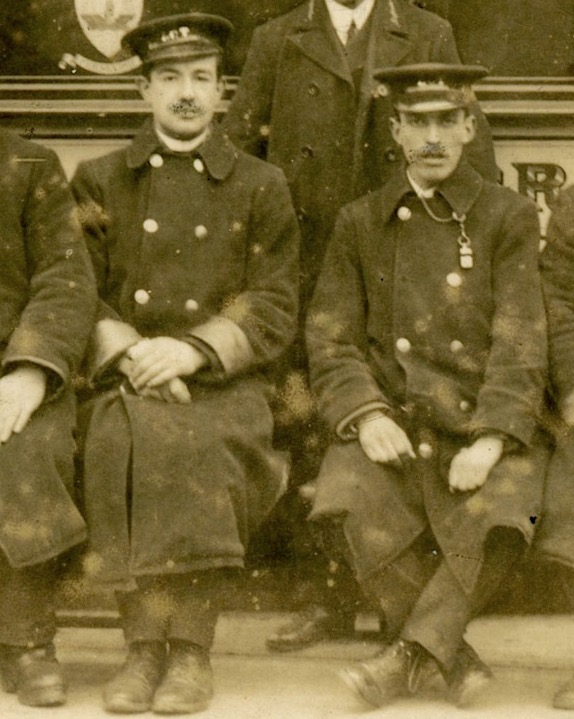
An enlargement of the above photograph showing two of the tramway men. The cap badge is simply made up of individual 'L C T' initials, probably brass.
Motormen and conductors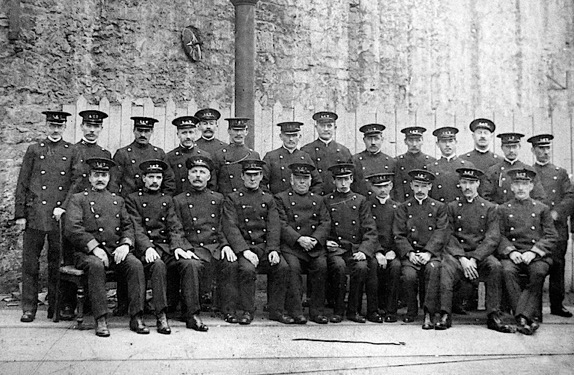
A photograph that was probably taken to show the staff in their new uniforms, presumably delivered for the inauguration of electric services in 1905. The caps bear individual system initials — 'L C T' — bespoke cap badges not being introduced until 1906 or possibly 1908.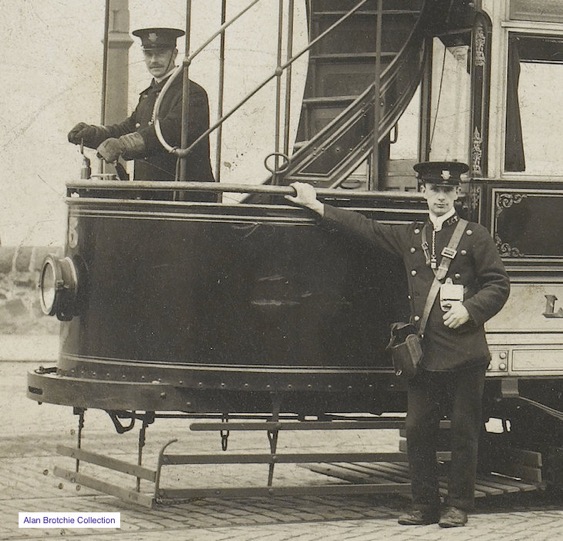
The crew of Tramcar No 5 sporting the new, bespoke cap badges — photo taken in Newhaven at the foot of Craighall Road in November 1906.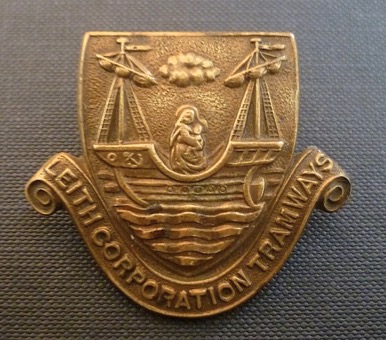
Leith Corporation Tramways cap badge — brass. Author's Collection.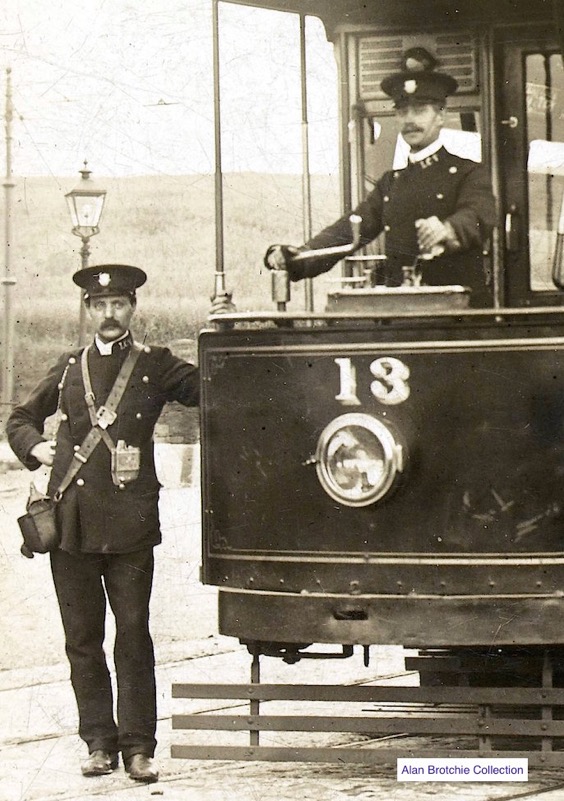
A conductor and a motorman pose for the camera with Tramcar No 13 at Granton Square, dating the photograph to around 1909 (the line was opened in May that year).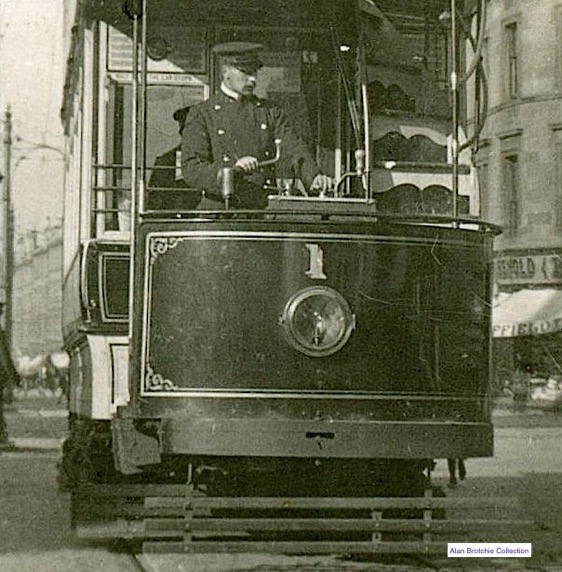
A motorman at the controls of Tramcar No 1 at Pilrig, some time prior to the Great War.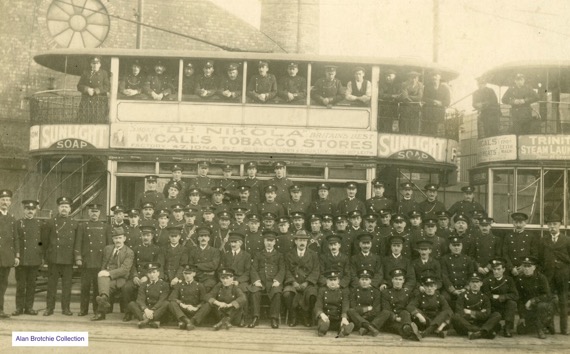
In all likelihood, the entire staff of Leith Corporation Tramways assembled at the depot — photo undated, but probably taken to mark the end of Leith as a separate system, following the municipality's merger with Edinburgh in late 1920. 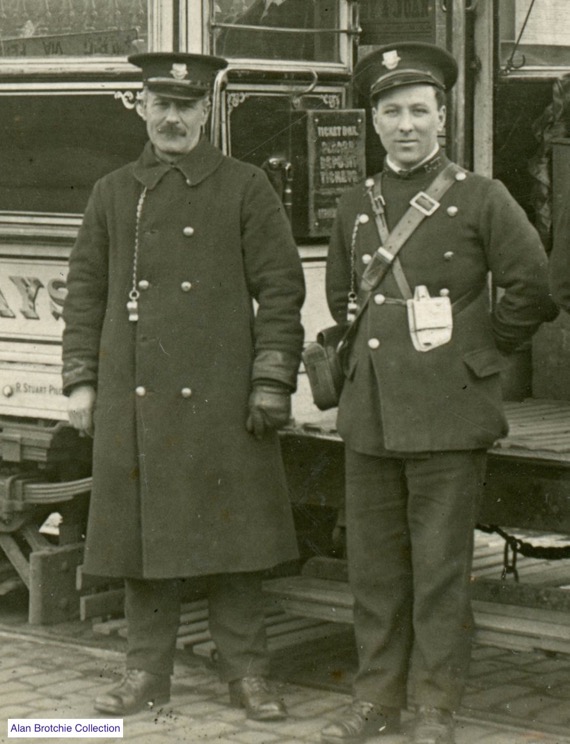
A motorman and a conductor with Tramcar No 266 (an ex Leith vehicle, but with its new Edinburgh Corporation number), with the crew still in Leith Corporation Tramways uniforms — photo undated, but probably taken in 1921.
Senior staff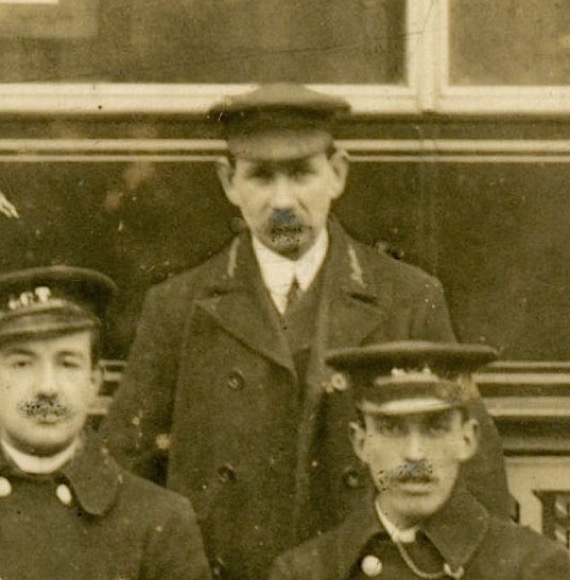
An enlargement of the horse-tram staff photograph above, showing an inspector. The collars of his topcoat bear his grade — 'Inspector' — in embroidered script lettering; the situation with respect to his cap badge is unclear.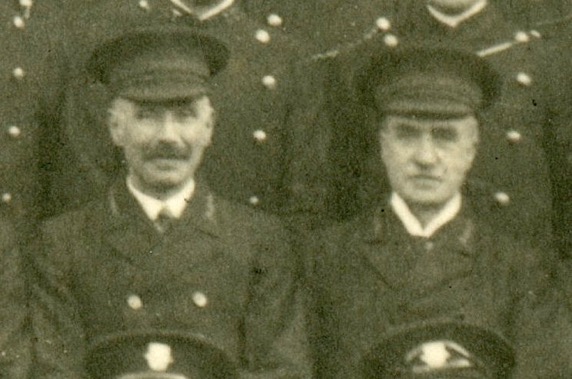
An enlargement of the 1920 staff photograph above showing two of the inspectors in long three-quarter length coats.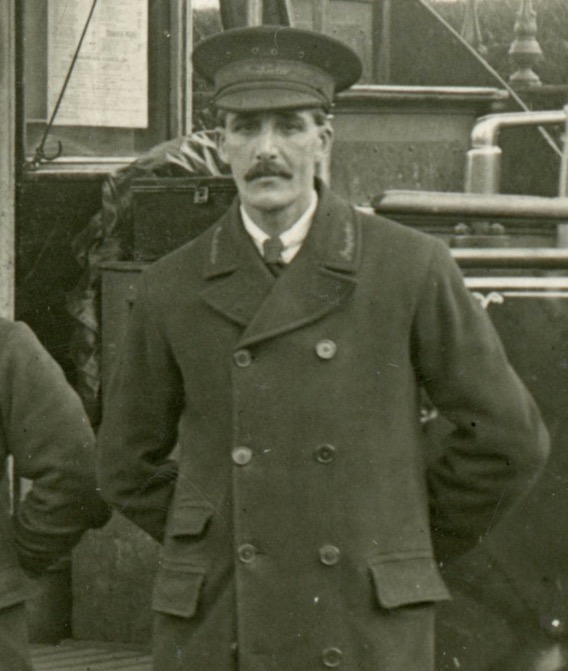
A Leith Corporation Tramways inspector — taken from the photograph depicting the crew of Tramcar No 266 above, i.e., shortly after the take-over by Edinburgh Corporation Tramways. He is wearing a long, double-breasted overcoat the bears plain (i.e., unmarked) buttons.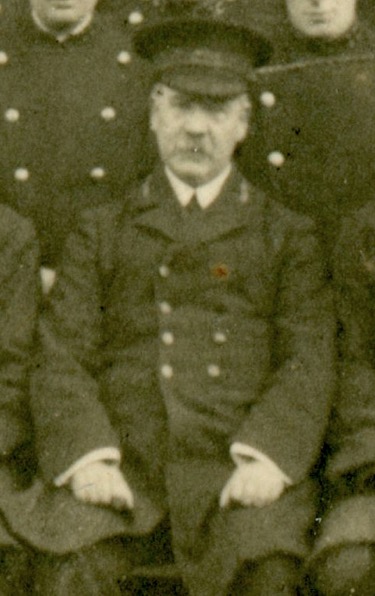
Another enlargement of the 1920 staff photograph, this time showing an individual who is, in all probability, a Chief Inspector.
Female staff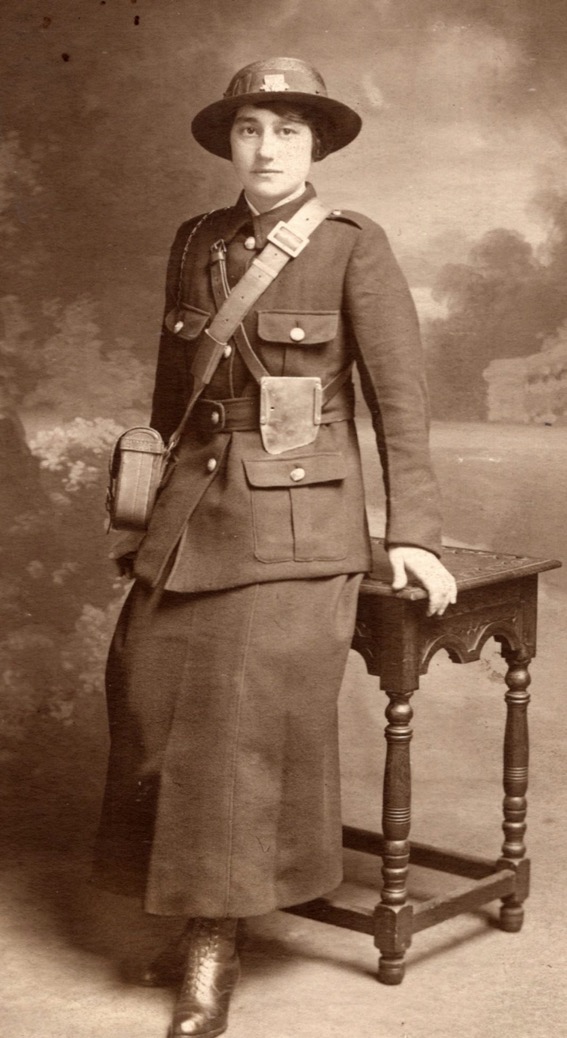
The only photograph I am aware of that depicts a Leith Corporation Tramways Great War conductress in a uniform jacket rather than a double-breasted topcoat. Photograph courtesy of Edinburgh Collected (see link).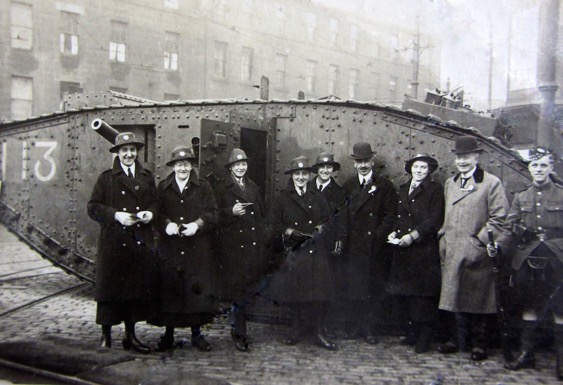
A group of Leith Corporation Tramways ladies (probably conductresses) pose for the camera with Mark IV tank 'Julian' at the 'Fit o' the Walk' in Leith, some time between Wednesday 23rd and Saturday 26th January 1918. 'Julian' toured many cities and towns in Scotland as a 'Tank Bank', getting people to invest in War Bonds and other government saving schemes. Thanks to Alan Brotchie for identifying the location.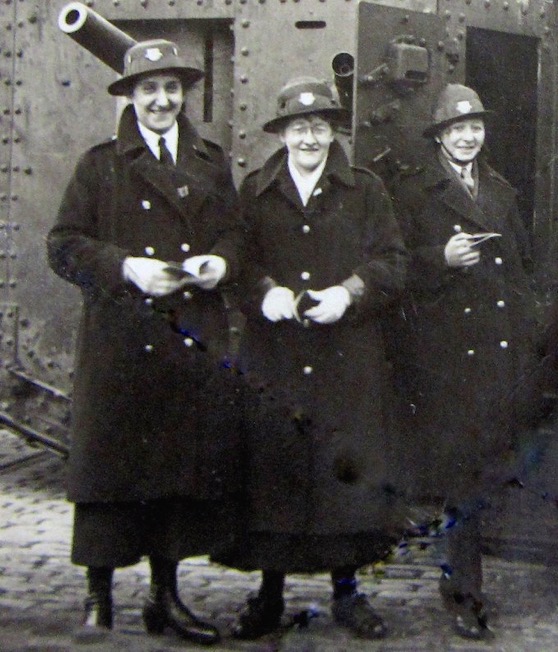
An enlargement of the above photograph showing three of the ladies. The bonnets were probably straw with a waterproof coating; one wonders what the ladies thought of them, as they cannot exactly be described as stylish.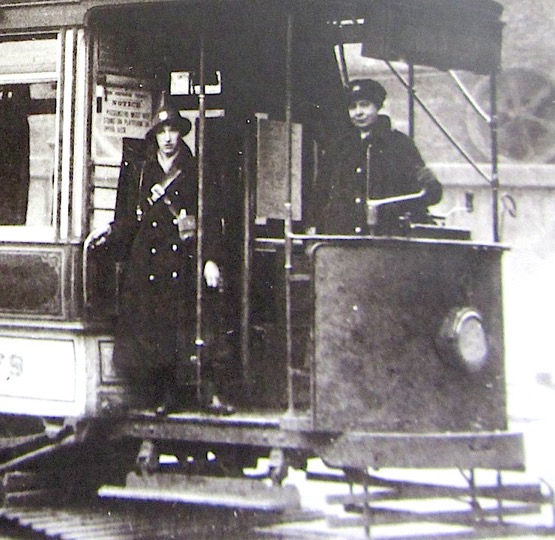
An LCT conductress and a motorwoman (called motoresses in Leith) aboard an unidentified tram — photo undated, but certainly taken in the Great War or shortly afterwards. The motorwoman appears to be wearing a baggy motor cap rather than the straw bonnet worn by her colleague.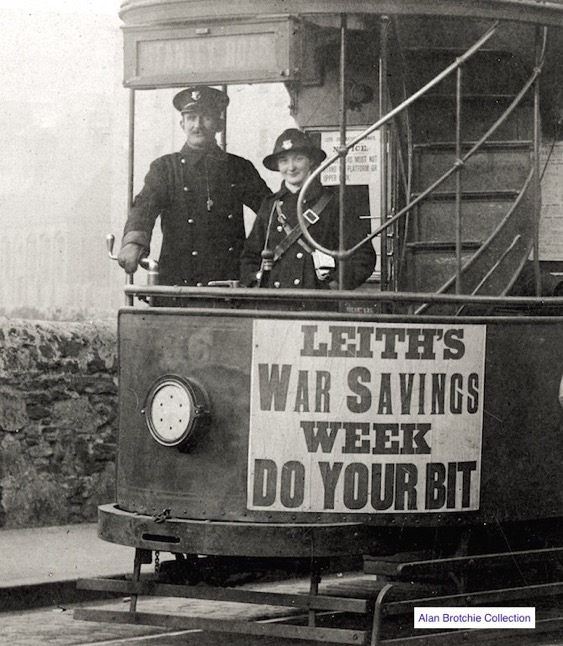
A motorman and a conductress aboard what is possibly Tramcar No 36 at the Seafield terminus — photo undated, but given the War Savings poster, possibly taken in January 1918.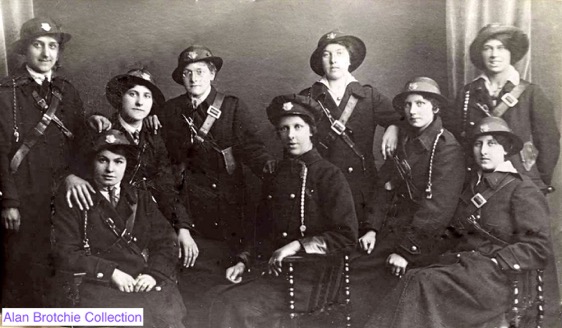
A studio photograph of eight LCT Great War conductresses and an inspectress.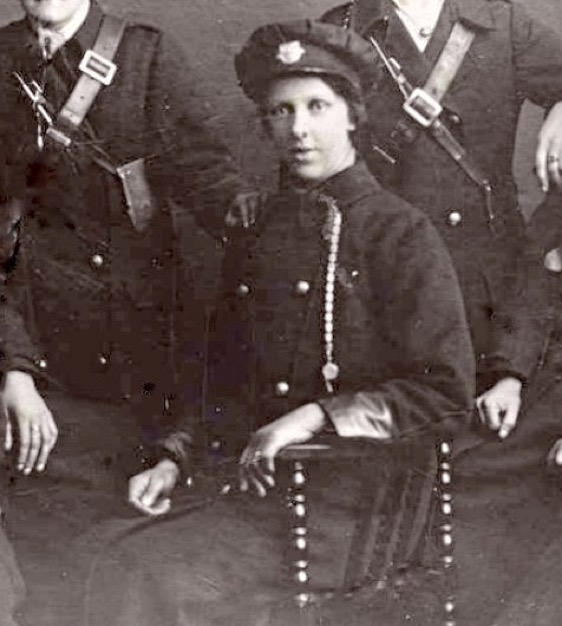
An enlargement of the above photograph showing the inspectress. She appears to be wearing a lancer-style topcoat rather than the style of topcoat worn by the conductresses, which appear to have had parallel pairs of buttons. It is unclear whether her cap is a motor cap, or some other form of peaked cap with a baggy rain cover.